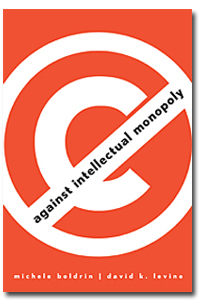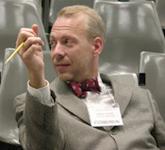 Against Intellectual Monopoly dares step out front, on a topic very dear to our hearts, to prove that "the great role of patents in giving us modern software is unadulterated fantasy." And they show this by reviewing the history of software innovation and its present workings. Neither Google nor YouTube nor any other driving force is using patents to retain competitive advantage, and those who do collect patents mostly do it in order to avoid patent trolls, e.g. those who would patent a technology already in use in order to possess and restrict its use.
Against Intellectual Monopoly dares step out front, on a topic very dear to our hearts, to prove that "the great role of patents in giving us modern software is unadulterated fantasy." And they show this by reviewing the history of software innovation and its present workings. Neither Google nor YouTube nor any other driving force is using patents to retain competitive advantage, and those who do collect patents mostly do it in order to avoid patent trolls, e.g. those who would patent a technology already in use in order to possess and restrict its use.
The lesson, however, applies far more broadly. Wealth in the Western world has been rising for a thousand years, and innovation along with it, and patents have played virtually no role whatsoever. The authors, in chapter 3, go more fully into the history of the patent to show that they originated out of kingly privilege associated with mercantilism and that the legislation of the 17th and 18th centuries were forms of liberalization, despite first appearances. It wasn’t until the 19th century that the laws tightened again.
Comprehensive "intellectual property laws" as they are today didn’t make an appearance until the end of the 19th century and the beginning of the 20th century. Taking the long view here, we can see even with a superficial look that economic growth throughout the world has been in process for 1000 years, while patents are new and mostly very narrow until quite recently.
Why did patents enter the picture? The rise of modern IP is due to the lobbying of incumbent firms threatened with competition. It is a complete myth that patents give rise to innovation; the reverse has been true: innovation gives rise to patents. The authors offer this incredible challenge: "Can anyone mention even one single case of a new industry emerging as a result of the protection of existing patent laws? We cannot… Strange coincidence, is it not?"
Examples. Services in the US were not covered by patent until the 1990s. In Italy, pharmaceutical products and processes were not covered until 1978. In Switzerland, it was 1954. Agricultural seeds and plants were not effectively patented until 1977 — but the greatest progress here occurred over the previous 100 years. Basic sciences like math and physics cannot be patented. The tendency in the biological and life sciences toward patents is a very grave sign for the future of these sectors.
The authors cite George Stigler in pointing out that patents did not assist "automobiles, frozen foods, various electrical appliances and equipment, petroleum refining, incandescent lamps, radio, and uranium mining." Stigler further cites the mail order business, which revolutionized retailing, as a case of patent-free development.
Shall we go on?
It helps to have the specifics that the authors provide. "Ray Kroc’s fastfood franchise (better known as McDonalds), the 24-hour convenience store, home delivery of pre-cooked food, the suburban shopping mall, franchise-everything (from coffee to hairdressing), the various steps that make up the delivery business of UPS, Federal Express, and DHL, and, obviously, online commerce. That is: pretty much each and every innovation which, during the last half century, has had any lasting impact in the retail and distribution sector was not spurred or protected by patents."
How did the inventor of the cotton gin — Eli Whitney — become rich? Not through the cotton gin! He and his business partner took out a patent and spent their energies crushing competition. They were trying to charge farmers two-fifths of their profits, paid in the form of cotton. Farmers hated it, and started to pirate the machine, and many competitive companies sprung up. Litigation followed and lasted from 1794 to 1807. Nothing came of it but an expense of time and energy, not to mention lawyer fees. The growth of cotton ginning in the South ended up owing more to the pirates than Whitney.
So where did Whitney get his money? How did he die rich? In 1798, he invented a process to manufacture muskets by machine. This time he was smart: he sought no patent. He encouraged "piracy," that is, imitation. The industry took off, and he remained the leader through innovation. What a blessed life to be rid of the stupid waste of using legal means to crush the competition and instead devote yourself to doing good for others and making money at the same time!
Here is the section in which the authors tell the story of agriculture. Before 1930, there was no patent protection — the very period in which the US became so productive in agriculture that the entire population shifted in its main industrial focus. After 1930, law granted only patents for a narrow range of plants. It wasn’t until 1970 that the Plant Variety Protection Act extended protection to sexually produced plants, and not until the 1980s when protection was extended to biotechnology. So we have a test case, and the authors measure innovation using total factor productivity. They find no increase after patents, and even some disturbing data oscillations. In corn in particular, the astounding increase in yields occurred before patents and have nearly leveled off since patents.
Two splashing examples of amazing innovation are now introduced in the book. The area of Almeria, Spain was an unusable dessert from the beginning of time until 1963, when an unpatented greenhouse was introduced into the area. The greenhouse was copied and copied and spread all over the region. The results can be seen from space with color photos reproduced in the book. The entire region was transformed from desolate to rich in the course of two decades. The same process took place in Treviso, Italy, where the read-to-color sweater was introduced by the Benetton family, and the process was imitated and spread to change an entire region in the absence of patent.
 But if patents really are that irrelevant, why don’t the captains of industry realize it? It turns out that they do. Two surveys in modern times asked R&D heads what techniques are most effective in realizing gains from innovation. It turns out that they regard the patent as the least effective means. The authors conclude this mind-blowing chapter with a long discussion of patent pools: these are cases in which companies relinquish patents in order to establish sharing agreements. It is a way of stepping sideways toward what the market would give us anyway.
But if patents really are that irrelevant, why don’t the captains of industry realize it? It turns out that they do. Two surveys in modern times asked R&D heads what techniques are most effective in realizing gains from innovation. It turns out that they regard the patent as the least effective means. The authors conclude this mind-blowing chapter with a long discussion of patent pools: these are cases in which companies relinquish patents in order to establish sharing agreements. It is a way of stepping sideways toward what the market would give us anyway.
Companies live and breathe by innovation. Innovation and monopoly are not compatible. We are back to an old lesson that remains true: it is the market and all that comes with it — not laws granting exclusive privileges to produce — that gives rise to innovation.
I end with a statement from Mises himself: "The great monopoly problem mankind has to face today is not an outgrowth of the operation of the market economy. It is a product of purposive action on the part of governments. It is not one of the evils inherent in capitalism as the demagogues trumpet. It is, on the contrary, the fruit of policies hostile to capitalism and intent upon sabotaging and destroying its operation."
Sometimes those most hostile to capitalism are the capitalists themselves!
Jeffrey Tucker [send him mail] is editorial vice president of www.Mises.org.



